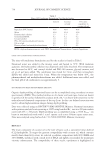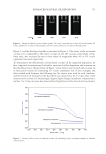671 THE MATRIX REVISITED WHAT IS THE MATRIX? More specifically, the cortex is a complex composite made of a number of components, the most important of which are crystalline keratin intermediate filaments (KIFs), amorphous keratin-associated proteins (KAPs), a medulla, a lipid-like cellular membrane complex (CMC), and melanin. The term “matrix,” as it is used today, was introduced by Feughelman (1) as part of his proposed two-phase (amorphous–crystalline) model of keratin fibers. That is, crystalline keratin rod structures pack within an amorphous keratin matrix (see Figure 1). EXPERIMENTAL DETAILS MECHANICAL TESTING All tensile testing was performed on a Dia-Stron MTT600 miniature tensile tester (Dia- Stron Ltd., Andover, UK) that was housed in a benchtop environmental chamber. Test samples consisted of 30 mm hair fibers that were sandwiched between two brass ferrules using a crimping block. Conventional tensile testing was performed by stretching 50 replicate test fibers to their break point at a rate of 40 mm/min. Wet-state testing was performed by filling the sample slots in the testing carousel with deionized water. Unless otherwise stated, dry-state testing was performed at 60% relative humidity (RH). The data shown in Figure 2 were generated in this manner. This article also shows data from an alternative approach to monitor the Young’s modulus of fibers as a function of the relative humidity (e.g., see Figures 3A and 11). In this instance, all fibers were extended to 5% extension at a rate of 10 mm/min after equilibration at a specific humidity. After this process, the initial structure of all fibers could be regenerated by equilibration at elevated (90%) humidity for 4 h. The same fibers could then be equilibrated at a new humidity before being rerun in a similar experiment. In this way, Young’s modulus results could be generated as a function of relative humidity without the need to prepare new samples each time. TORSION TESTING Torsional moduli were measured using a torsion pendulum approach that was described previously (2). In short, experiments were performed on a custom-built instrument with Figure 1. Two-phase model of keratin fibers according to Feughelman’s original model (1).
672 JOURNAL OF COSMETIC SCIENCE which individual fibers were automatically and reproducibly induced into a twisting motion. The periodicity and dampening of this motion was then used to calculate mechanical parameters associated with this mode of deformation. The instrument was housed in a benchtop environmental chamber, and testing involved 30 replicate fibers per test condition. DIFFERENTIAL SCANNING CALORIMETRY Wet-state differential scanning calorimetry (DSC) investigations were performed on a PerkinElmer DSC 8500 instrument using pressure-resistant (25 bar) stainless steel large- volume capsules (PerkinElmer). The temperature was increased from 50 to 180°C at a heating rate of 10°C/min, while the chamber was being flushed with a nitrogen flow of 10 mL/min. Previously conditioned snippets of 5–6 mg from each sample were precisely weighed and placed in the stainless steel crucible. Then, 50 μL of distilled water (pH 6.7) was added, and the crucible was sealed and stored overnight. Dry-state DSC measurements were performed on a Netzsch DSC 204 instrument using aluminum pans. The temperature was increased from 50 to 250°C at a heating rate of 10°C/ min, while the chamber was being flushed with a nitrogen flow of 20 mL/min. Previously conditioned snippets of 5–6 mg from each sample were precisely weighed and placed in the aluminum crucible, which was covered with a lid. The lid was double pierced to allow product gases to evolve. Calibration in all DSC experiments was performed using indium and palmitic acid, both of high purity. For each sample, three measurements were performed to ensure reproducibility of the data, and the peak temperature, T p , and enthalpy, ΔH, of the endothermal effect were recorded. ATOMIC FORCE MICROSCOPY NANOINDENTATION Individual hair fibers from each sample were embedded in Epon 812 resin (TAAB Laboratories Equipment Ltd., Aldermaston, Berkshire, UK) by applying the mixed resin directly to the hair fibers, thereby avoiding infiltration of the resin into the sample. After curing, the resin blocks were mounted on steel atomic force microscopy (AFM) sample stubs with epoxy adhesive, and smooth axial and longitudinal sections of the hairs were obtained with an Ultracut N ultramicrotome (Reichert-Nissei, Tokyo, Japan) equipped with a diamond knife (Ultra 45, Diatome Ltd., Biel, Switzerland). Nanoindentation experiments were performed with an MFP-3D scanning probe microscope (Asylum Research, Santa Barbara, California) equipped with a closed cell consisting of a reservoir situated around the sample mounting and a magnetically sealed rubber gasket attached to the head of the microscope. Various humidity conditions were achieved in the AFM cell through the use of saturated solutions of various chemicals, which were placed in the reservoir before the cell was sealed. Details of the methods for calibrating the equipment for measurement and acquiring and evaluating the data are available elsewhere (3).
Purchased for the exclusive use of nofirst nolast (unknown) From: SCC Media Library & Resource Center (library.scconline.org)






































































































































